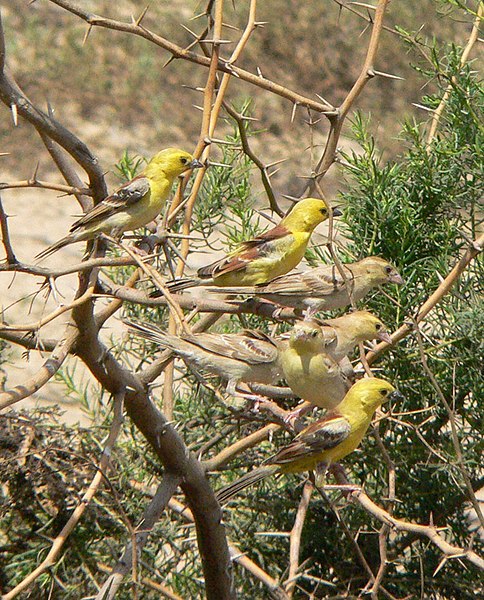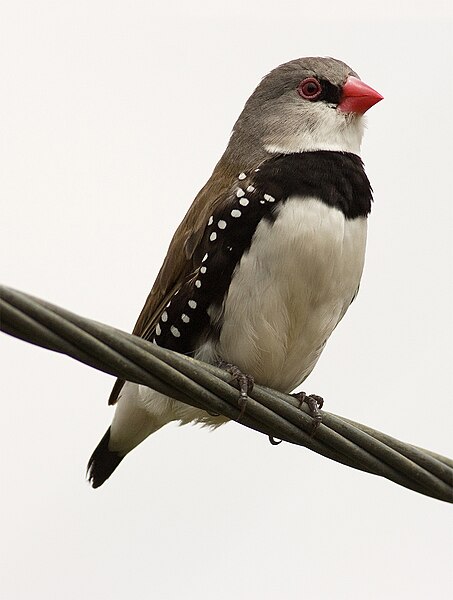 Sparrows do not come to most people’s minds when considering a new pet bird, but a surprising array of beautiful, hardy species are regularly bred in captivity. Today I’ll cover several of my favorites – the Rufus-Collared, Sudan Golden and Diamond Sparrows, and the Cinnamon-Breasted Rock Bunting.
Sparrows do not come to most people’s minds when considering a new pet bird, but a surprising array of beautiful, hardy species are regularly bred in captivity. Today I’ll cover several of my favorites – the Rufus-Collared, Sudan Golden and Diamond Sparrows, and the Cinnamon-Breasted Rock Bunting.
“Sparrow, Bunting or Finch”?
Aviculturists apply the term “sparrow” to a wide variety of small birds that are not necessarily related, and that are more properly classified as finches. Ornithologists generally consider birds in the Old World genus Passer to be the “True Sparrows” and those in the family Emberizidae to be the “New World Sparrows and Buntings”. The genus Passer is home to the widespread House Sparrow, P. domesticus – not a species that is often kept, but which I’ve found to be a delightful captive.
In this article I’ll stick to popular usage and cover species that are termed “sparrow” or “bunting” by bird-keepers…please write in if you would like detailed information concerning their taxonomy.
Basic Care
The birds cove red here are quite active and do best in well-planted outdoor aviaries or large flight cages where they can occupy themselves by foraging among plants and leaf litter.
The basic diet should be comprised of a well-balanced finch seed mix, to which has been added native (collected or grown) seeds, egg food, softbill diet and sprouts. Crickets, mealworms, moths and other insects should be offered throughout the year, and are critical when young are being raised. Grit and cuttlebone should always be available.
Sudan Golden Sparrow, Auripasser luteus
Also known as the Yellow or Golden Song Sparrow, this aptly-named African native is brilliant yellow with a chestnut back and brown wings. Fortunately, it is as hardy as it is brightly-colored, although captive breeding is not common.
It does best in a well-planted outdoor aviary or very large flight cage, and does not take well to unexpected noise and other such disturbances. Mated pairs are intolerant of nest inspections and quick to abandon their eggs.
Rufus-Collared Sparrow, Zonotrichia capensis
Clad in burnt-orange, black, white and gray, this 6 inch-long sparrow stands out in any collection. Its stout beak enables it to take a wide range of seeds and insects, and captives do best when offered a highly-varied diet.
Native to Central and South America, the Rufus-Collared Sparrow gets along well with similarly sized finches and softbills, but nesting pairs are best maintained alone.
Diamond Sparrow or Firetail, Steganopleura gutta
 This Australian native is one of the most distinctly-marked cage birds available. The crimson rump and beak contrast sharply with the soft-gray plumage and black tail, and the flanks are jet black with bold white spots.
This Australian native is one of the most distinctly-marked cage birds available. The crimson rump and beak contrast sharply with the soft-gray plumage and black tail, and the flanks are jet black with bold white spots.
The Diamond Finch is protected in Australia, but well-established in captivity. It is a reliable breeder, but pairs are difficult to identify other than by behavior, as the sexes are alike in appearance.
Cinnamon-Breasted Rock Bunting, Emberiza tahapisi
At 7 inches in length, the stoutly-built Rock Bunting is larger than most finches and sparrows, and best maintained in an outdoor aviary or indoor bird room. Cage length is more important than height, as it forages, and often nests, on the ground.
Ranging over much of Sub-Saharan Africa, this pert, alert bird favors rocky scrub and overgrown grasslands. It is clad in rust or reddish-brown, white and black, and, given its size, makes a most impressive addition to any collection. Insects figure importantly in its diet and, along with ample space, are critical to its care.
Further Reading
Keeping and Breeding the Golden Sparrow
Rock Bunting Natural History
Golden Sparrows image referenced from wikipedia and originally posted by ChriKo
Diamond Firetail image referenced from wikipedia and originally posted by JJ Harrison
 That Bird Blog – Bird Care and History for Pet Birds
That Bird Blog – Bird Care and History for Pet Birds




Always enjoy hearing about different pet species. Those Diamond sparrows are gorgeous! Might have to consider them in the future!
Hello Alicia, Frank Indiviglio here.
Thanks for your interest in our blog. I look forward to your future comments.
Please let me know if you need any further information. Good luck, enjoy and please keep me posted.
Best regards, Frank Indiviglio.